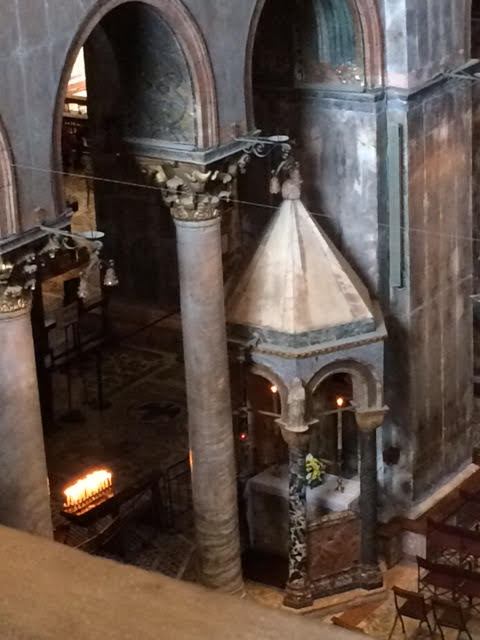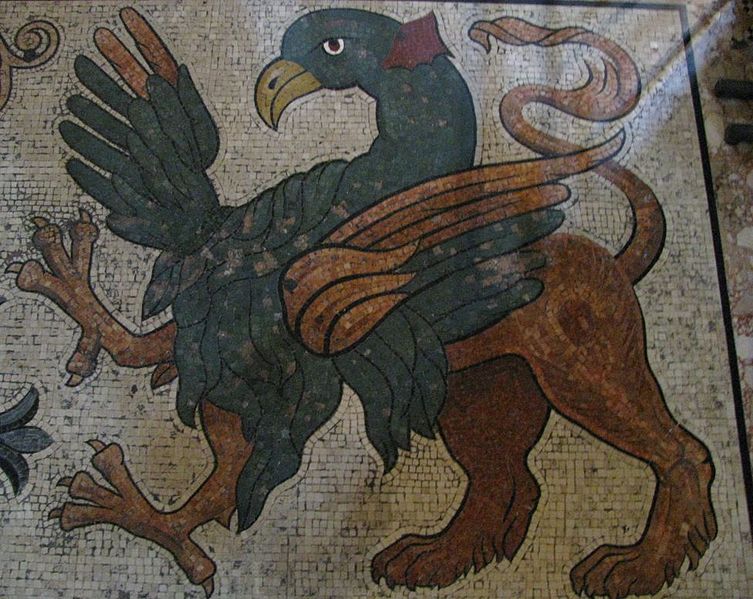
The tiny shrine or chapel in St. Mark’s Basilica (Venice) known as “Il Capitello.” (photo by Stephen Morris)
The shrine set up against a pillar on the north aisle of the nave in St. Mark’s Basilica is known as “The Capitello.” It shelters a Byzantine painted crucifix, brought to Venice in 1290 from Constantinople and is said to have shed blood; some of this blood is kept in a reliquary on display in the treasury of the basilica. (Nearby is another icon, also brought from Constantinople after the Fourth Crusade in 1204. The icon of the Virgin Nicopeia, also known as “Our Lady Who Brings Victory,” was probably one of the most precious objects taken from Constantinople. This icon of the Virgin Nicopeia was probably the original occupant of the Capitello shrine. The icon was only moved to the nearby chapel during the late 1500s or early 1600s.)
There are Annunciation figures (the angel Gabriel and the Virgin Mary) on the columns supporting the shrine’s roof; these Annunciation figures would match the presence of the Nicopeia icon better than they do the presence of the Cross, although the Annunciation and the Crucifixion were thought to have both occurred on March 25.
The roof (baldacchino) of the shrine itself is octagonal. Many early and medieval Christian buildings were octagons, especially those designed for the celebration of baptism or burial. This was because the number 8 figured prominently in early Christian preaching about the Resurrection and eternity.
St. Basil the Great preaches in the fourth century that “The day of the Lord” is another way to say “eternity.” He points out that if we call it “the day of the Lord,” that does not mean there is another one. It is unique. This eternal, everlasting day, being outside the regular cycle of 7-day weeks, is sometimes itself called the “eighth day.”
“This is the day that the Psalmist calls the eighth day, because it is outside this time of weeks. Thus whether you call it day, or whether you call it eternity, you express the same idea.” (Basil the Great, Hexameron 2)
The story of creation in Genesis does not say “on the first day” in Greek; it reads, “on Day One.” Basil suggests that the “day one” of creation is meant to suggest not only eternity but already anticipates the Resurrection of Christ:
“Thus it is in order that you may carry your thoughts forward towards a future life, that Scripture marks by the word “one” the day which is the type of eternity, the first fruits of days, the contemporary of light, the holy Lord’s day honored by the Resurrection of our Lord. ‘And the evening and the morning were one day.'” (Hexameron 2)
Basil is telling his congregation that every Sunday is the “eighth day,” the day of the Resurrection, and therefore every Sunday – the day on which the Eucharist is celebrated – can be their first experience of eternity.

There are mosaics of griffins on the floor beside The Capitello shrine. Griffins are known for guarding treasure and priceless possessions

The icon of Our Lady Who Brings Victory, stolen from Constantinople after the Fourth Crusade in 1204, was originally enshrined in the “il capitello” shrine in Venice’s Basilica of St. Mark.
